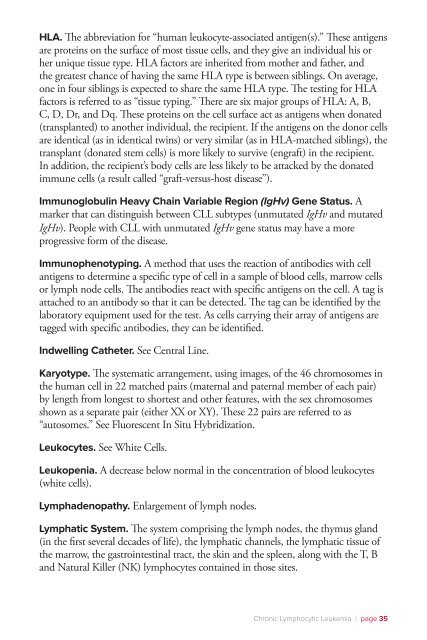Chronic Lymphocytic Leukemia - The Leukemia & Lymphoma Society
Chronic Lymphocytic Leukemia - The Leukemia & Lymphoma Society
Chronic Lymphocytic Leukemia - The Leukemia & Lymphoma Society
You also want an ePaper? Increase the reach of your titles
YUMPU automatically turns print PDFs into web optimized ePapers that Google loves.
HLA. <strong>The</strong> abbreviation for “human leukocyte-associated antigen(s).” <strong>The</strong>se antigens<br />
are proteins on the surface of most tissue cells, and they give an individual his or<br />
her unique tissue type. HLA factors are inherited from mother and father, and<br />
the greatest chance of having the same HLA type is between siblings. On average,<br />
one in four siblings is expected to share the same HLA type. <strong>The</strong> testing for HLA<br />
factors is referred to as “tissue typing.” <strong>The</strong>re are six major groups of HLA: A, B,<br />
C, D, Dr, and Dq. <strong>The</strong>se proteins on the cell surface act as antigens when donated<br />
(transplanted) to another individual, the recipient. If the antigens on the donor cells<br />
are identical (as in identical twins) or very similar (as in HLA-matched siblings), the<br />
transplant (donated stem cells) is more likely to survive (engraft) in the recipient.<br />
In addition, the recipient’s body cells are less likely to be attacked by the donated<br />
immune cells (a result called “graft-versus-host disease”).<br />
Immunoglobulin Heavy Chain Variable Region (IgHv) Gene Status. A<br />
marker that can distinguish between CLL subtypes (unmutated IgHv and mutated<br />
IgHv). People with CLL with unmutated IgHv gene status may have a more<br />
progressive form of the disease.<br />
Immunophenotyping. A method that uses the reaction of antibodies with cell<br />
antigens to determine a specific type of cell in a sample of blood cells, marrow cells<br />
or lymph node cells. <strong>The</strong> antibodies react with specific antigens on the cell. A tag is<br />
attached to an antibody so that it can be detected. <strong>The</strong> tag can be identified by the<br />
laboratory equipment used for the test. As cells carrying their array of antigens are<br />
tagged with specific antibodies, they can be identified.<br />
Indwelling Catheter. See Central Line.<br />
Karyotype. <strong>The</strong> systematic arrangement, using images, of the 46 chromosomes in<br />
the human cell in 22 matched pairs (maternal and paternal member of each pair)<br />
by length from longest to shortest and other features, with the sex chromosomes<br />
shown as a separate pair (either XX or XY). <strong>The</strong>se 22 pairs are referred to as<br />
“autosomes.” See Fluorescent In Situ Hybridization.<br />
Leukocytes. See White Cells.<br />
Leukopenia. A decrease below normal in the concentration of blood leukocytes<br />
(white cells).<br />
Lymphadenopathy. Enlargement of lymph nodes.<br />
Lymphatic System. <strong>The</strong> system comprising the lymph nodes, the thymus gland<br />
(in the first several decades of life), the lymphatic channels, the lymphatic tissue of<br />
the marrow, the gastrointestinal tract, the skin and the spleen, along with the T, B<br />
and Natural Killer (NK) lymphocytes contained in those sites.<br />
<strong>Chronic</strong> <strong>Lymphocytic</strong> <strong>Leukemia</strong> I page 35

















